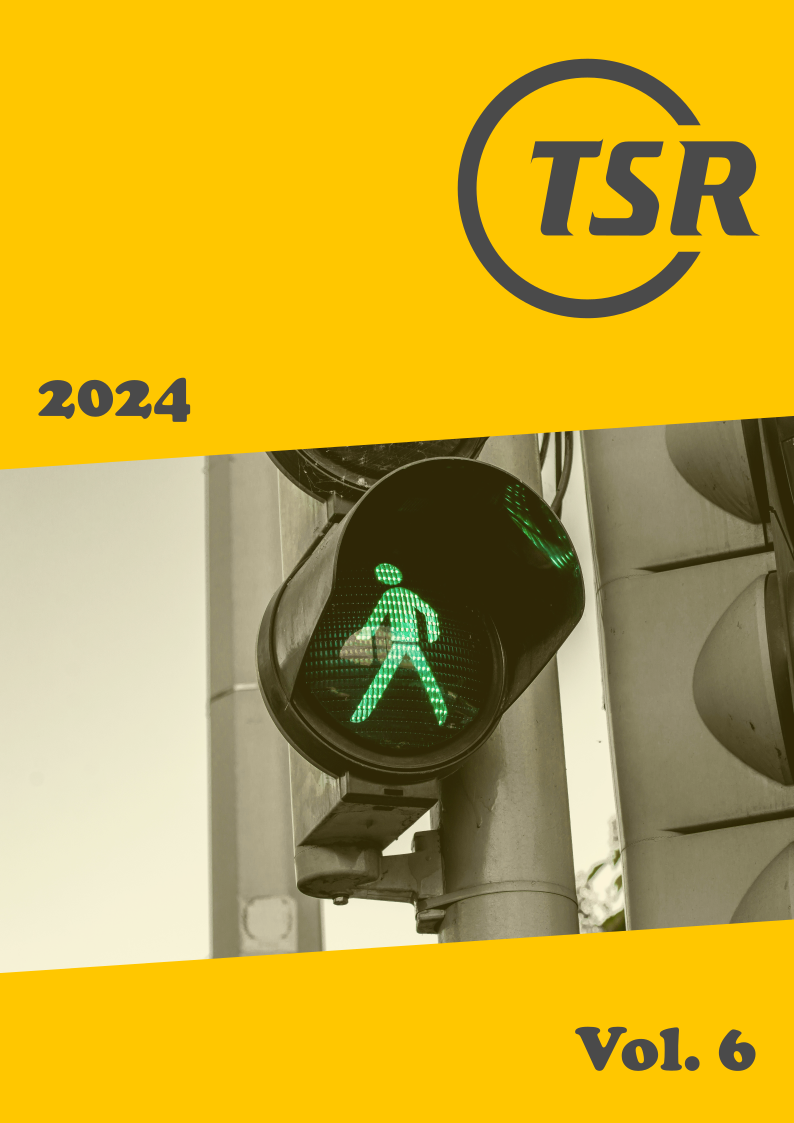The importance of individual characteristics on bicycle performance during alcohol intoxication
DOI:
https://doi.org/10.55329/vmgb9648Keywords:
alcohol intoxication, bicycling stability, cognitive performance, group characteristics, self-rated bicycling abilitiesAbstract
Bicycling accidents are a well-known problem for traffic safety globally. Alcohol intoxication is one possible factor, although the exact number of accidents due to intoxication is difficult to establish. Not all bicyclists act in the same way, particularly when under the influence of alcohol, i.e. bicycling performance might be related to a bicyclist's personal characteristics. This study aimed to investigate if the bicyclist's characteristics (bicycling experience, physical fitness, or sensation seeking scores) influence bicycling stability, cognitive performance, or self-rated bicycling ability ratings at different levels of alcohol intoxication. The experiment was completed on a wide treadmill, which allowed control of several influencing factors such as speed and physical effort. Intoxicated and sober participants bicycled on the treadmill five times for 10 minutes each time, and breath alcohol concentration (BrAC) levels were measured five times. Participants were given doses of alcohol up to a BrAC level of 0.8‰. The results revealed that alcohol intoxication had a significant effect on stability, cognitive executive functions, and self-rated ability to bicycle on the treadmill. Group characteristics had an effect on bicycling performance and on self-ratings of bicycling ability when intoxicated. Alcohol intoxication affects stability, cognitive performance, and perceived ability to bicycle. Group characteristics are important for examining possible self-regulated behavior, as some groups rate that they can bicycle safely, even when there is an objective decrease in stability and executive functions.
Downloads
References
Adminaité-Fodor, D., G. Jost (2020), 'How safe is walking and cycling in Europe?', European Transport Safety Council, PIN Flash Report 38.
Ahlstrom, C., K. Kircher, B. Thorslund, E. Adell (2016), 'Bicyclists’ visual strategies when conducting self-paced vs. system-paced smartphone tasks in traffic', Transportation Research Part F: Traffic Psychology and Behaviour, 41(Part B), 204–216. DOI: https://doi.org/10.1016/j.trf.2015.01.010
Airaksinen, N. K., I. S. Nurmi-Lüthje, J. M. Kataja, H. P. J. Kröger, P. M. J. Lüthje (2018), 'Cycling injuries and alcohol', Injury, 49(5), 945–952. DOI: https://doi.org/10.1016/j.injury.2018.03.002
Andersson, J., C. Patten, H. Wallén Warner, C. Andersérs, C. Ahlström, R. Ceci, L. Jakobsson (2023), 'Bicycling during acute alcohol intoxication', Traffic Safety Research, 4, 000028. DOI: https://doi.org/10.55329/prpa1909
Asbridge, M., R. Mann, M. D. Cusimano, J. M. Tallon, C. Pauley, J. Rehm (2014), 'Cycling-related crash risk and the role of cannabis and alcohol: A case-crossover study', Preventive Medicine, 66, 80–86. DOI: https://doi.org/10.1016/j.ypmed.2014.06.006
Babor, T. F., J. C. Higgins-Biddle, J. B. Saunders, M. G. Monteiro (2001), 'The alcohol use disorders identification test: guidelines for use in primary care', AUDIT, (Geneva, Switzerland: WHO).
Billot-Grasset, A., E. Amoros, M. Hours (2016), 'How cyclist behavior affects bicycle accident configurations?', Transportation Research Part F: Traffic Psychology and Behaviour, 41(Part B), 261–276. DOI: https://doi.org/10.1016/j.trf.2015.10.007
Bronstad, P. M., A. Albu, R. Goldstein, E. Peli, A. R. Bowers (2016), 'Driving with central field loss III: vehicle control', Clinical and Experimental Optometry, 99(4). DOI: https://doi.org/10.1111/cxo.12432
Cain, S. M., J. A. Ashton-Miller, N. C. Perkins (2016), 'On the skill of balancing while riding a bicycle', PLOS ONE, 11(2). DOI: https://doi.org/10.1371/journal.pone.0149340
Cash, C., A. Peacock, H. Barrington, N. Sinnett, R. Bruno (2015), 'Detecting impairment: Sensitive cognitive measures of dose-related acute alcohol intoxication', Journal of Psychopharmacology, 29(4), 436–446. DOI: https://doi.org/10.1177/0269881115570080
Chang, Y. K., J. D. Labban, J. I. Gapin, J. L. Etnier (2012), 'The effects of acute exercise on cognitive performance: A meta-analysis', Brain Research, 1453, 87–101. DOI: https://doi.org/10.1016/j.brainres.2012.02.068
Chen, Y.-L., Y.-N. Liu (2014), 'Optimal protruding node length of bicycle seats determined using cycling postures and subjective ratings', Applied Ergonomics, 45(4), 1181–1186. DOI: https://doi.org/10.1016/j.apergo.2014.02.006
de Waard, D., S. Houwing, B. Lewis-Evans, D. Twisk, K. Brookhuis (2016), 'Bicycling under the influence of alcohol', Transportation Research Part F: Traffic Psychology and Behaviour, 41(Part B), 302–308. DOI: https://doi.org/10.1016/j.trf.2015.03.003
Esmaeilikia, M., I. Radun, R. Grzebieta, J. Olivier (2019), 'Bicycle helmets and risky behaviour: A systematic review', Transportation Research Part F: Traffic Psychology and Behaviour, 60, 299–310. DOI: https://doi.org/10.1016/j.trf.2018.10.026
Feenstra, H., R. A. Ruiter, G. Kok (2010), 'Social-cognitive correlates of risky adolescent cycling behavior', BMC Public Health, 10, 408. DOI: https://doi.org/10.1186/1471-2458-10-408
Gamble, T., I. Walker (2016), 'Wearing a bicycle helmet can increase risk taking and sensation seeking in adults', Psychological Science, 27(2), 289–294. DOI: https://doi.org/10.1177/0956797615620784
George, S., R. D. Rogers, T. Duka (2005), 'The acute effect of alcohol on decision making in social drinkers', Psychopharmacology, 182, 160–169. DOI: https://doi.org/10.1007/s00213-005-0057-9
Gevins, A., B. Cutillo (1993), 'Spatiotemporal dynamics of component processes in human working memory', Electroencephalography and Clinical Neurophysiology, 87(3), 128–143. DOI: https://doi.org/10.1016/0013-4694(93)90119-G
Greenstein, J. E., J. D. Kassel, M. C. Wardle, J. C. Veilleux, D. P. Evatt, A. J. Heinz, L. L. Roesch, A. R. Braun, M. C. Yates (2010), 'The separate and combined effects of nicotine and alcohol on working memory capacity in nonabstinent smokers', Experimental and Clinical Psychopharmacology, 18(2), 120–128. DOI: https://doi.org/10.1037/a0018782
Hartung, B., N. Mindiashvili, R. Maatz, H. Schwender, E. H. Roth, S. Ritz-Timme, J. Moody, A. Malczyk, T. Daldrup (2015), 'Regarding the fitness to ride a bicycle under the acute influence of alcohol', International Journal of Legal Medicine, 129, 471–480. DOI: https://doi.org/10.1007/s00414-014-1104-z
Hittner, J. B., R. Swickert (2006), 'Sensation seeking and alcohol use: A meta-analytic review', Addictive Behaviors, 31(8), 1383–1401. DOI: https://doi.org/10.1016/j.addbeh.2005.11.004
Hoffman, L. A., A. L. Sklar, S. J. Nixon (2015), 'The effects of acute alcohol on psychomotor, set-shifting, and working memory performance in older men and women', Alcohol, 49(3), 185–191. DOI: https://doi.org/10.1016/j.alcohol.2015.02.001
Juric, A., A. Fijacko, L. Bakulic, T. Orešic, I. Gmajnicki (2018), 'Evaluation of breath alcohol analysers by comparison of breath and blood alcohol concentrations', Arhiv Za Higijenu Rada i Toksikologiju, 69(1), 69–76. DOI: https://doi.org/10.2478/aiht-2018-69-3064
Kovacsova, N., J. C. F. D. Winter, A. L. Schwab, M. Christoph, D. A. M. Twisk, M. P. Hagenzieker (2016), 'Riding performance on a conventional bicycle and a pedelec in low speed exercises: Objective and subjective evaluation of middle-aged and older persons', Transportation Research Part F: Traffic Psychology and Behaviour, 42(Part 1), 28–43. DOI: https://doi.org/10.1016/j.trf.2016.06.018
Li, G., S. P. Baker, J. E. Smialek, C. A. Soderstrom (2001), 'Use of alcohol as a risk factor for bicycling injury', JAMA, 285(7), 893–896. DOI: https://doi.org/10.1001/jama.285.7.893
Li, Z., X. Li, X. Zhao, Q. Zhang (2019), 'Effects of Different Alcohol Dosages on Steering Behavior in Curve Driving', Human Factors: The Journal of the Human Factors and Ergonomics Society, 61(1). DOI: https://doi.org/10.1177/0018720818791850
Lyvers, M., J. Tobias-Webb (2010), 'Effects of acute alcohol consumption on executive cognitive functioning in naturalistic settings', Addictive Behaviors, 35(11), 1021–1028. DOI: https://doi.org/10.1016/j.addbeh.2010.06.022
Macdonald, W. A., E. R. Hoffman (1980), 'Review of relationships between steering wheel reversal rate and driving task demand', Human Factors, 22(6), 733–739. DOI: https://doi.org/10.1177/001872088002200609
Martínez-Ruiz, V., P. Lardelli-Claret, E. Jiménez-Mejías, C. Amezcua-Prieto, J. J. Jiménez-Moleón, J. D. D. Luna del Castillo (2013), 'Risk factors for causing road crashes involving cyclists: An application of a quasi-induced exposure method', Accident Analysis & Prevention, 51, 228–237. DOI: https://doi.org/10.1016/j.aap.2012.11.023
Michel, G., M.-C. Mouren-Siméoni, F. Perez-Diaz, B. Falissard, S. Carton, R. Jouvent (1998), 'Construction and validation of a sensation seeking scale for adolescents', Personality and Individual Differences, 26(1), 159–174. DOI: https://doi.org/10.1016/S0191-8869(98)00059-2
Mintzer, M. Z. (2007), 'The effects of alcohol on memory: A review of laboratory studies in healthy adults', International Journal on Disability and Human Development, 6(4), 397–403. DOI: https://doi.org/10.1515/IJDHD.2007.6.4.397
Park, M.-S., S. Sohn, J.-E. Park, S.-H. Kim, Y. I K, J.-H. Sohn (2011), 'Brain functions associated with verbal working memory tasks among young males with alcohol use disorders', Scandinavian Journal of Psychology, 52(1), 1–7. DOI: https://doi.org/10.1111/j.1467-9450.2010.00848.x
Radun, I., J. Radun, M. Esmaeilikia, T. J. Lajunen (2018), 'Risk compensation and bicycle helmets: A false conclusion and uncritical citations', Transportation Research Part F: Traffic Psychology and Behaviour, 58, 548–555. DOI: https://doi.org/10.1016/j.trf.2018.06.038
Ralevski, E., E. B. Perry, D. C. D’Souza, V. Bufis, J. Elander, D. Limoncelli, M. Vendetti, E. Dean, T. B. Cooper, S. McKee, I. Petrakis (2012), 'Preliminary findings on the interactive effects of IV ethanol and IV nicotine on human behavior and cognition: A laboratory study', Nicotine & Tobacco Research, 14(5), 596–606. DOI: https://doi.org/10.1093/ntr/ntr258
Rizzi, M. C., M. Rizzi, A. Kullgren, B. Algurén (2020), 'The potential of different countermeasures to prevent injuries with high risk of health loss among bicyclists in Sweden', Traffic Injury Prevention, 21(3), 215–221. DOI: https://doi.org/10.1080/15389588.2020.1730827
Schyllander, J., R. Ekman (2013), 'Skadade cyklister—en studie av skadeutveckling över tid: Statistik och analys [Injured cyclists—a study of injury development over time: statistics and analysis]', MSB, MSB579.
Sethi, M., J. H. Heyer, S. Wall, C. DiMaggio, M. Shinseki, D. Slaughter, S. G. Frangos (2016), 'Alcohol use by urban bicyclists is associated with more severe injury, greater hospital resource use, and higher mortality', Alcohol, 53, 1–7. DOI: https://doi.org/10.1016/j.alcohol.2016.03.005
Socialstyrelsen, (2022), 'Alcohol use disorders identification test (AUDIT)', Socialstyrelsen.
Spinola, S., S. A. Maisto, C. N. White, T. Huddleson (2017), 'Effects of acute alcohol intoxication on executive functions controlling self-regulated behavior', Alcohol, 61, 1–8. DOI: https://doi.org/10.1016/j.alcohol.2017.02.177
van Lunteren, A., H. G. Stassen, M. S. H. Schlemper (1970), 'On the influence of drugs on the behavior of a bicycle rider', 6th Annual Conference on Manual Control, Ohio, US, 7—9 April.
Wallén Warner, H., Å. Forsman, S. Gustafsson, J. Ihlström, J. Nyberg (2017), 'Alkohol och cykling: en multidisciplinär studie [Alcohol and cycling: a multidisciplinary study]', VTI, VTI rapport 945.
Wang, C., Z. Li, R. Fu, Y. Guo, W. Yuan (2019), 'What is the difference in driver’s lateral control ability during naturalistic distracted driving and normal driving? A case study on a real highway', Accident Analysis & Prevention, 125, 98–105. DOI: https://doi.org/10.1016/j.aap.2019.01.030
Weiss, E., J. Marksteiner (2007), 'Alcohol-related cognitive disorders with a focus on neuropsychology', International Journal on Disability and Human Development, 6(4), 337–342. DOI: https://doi.org/10.1515/IJDHD.2007.6.4.337
Westerhuis, F., D. de Waard (2017), 'Reading cyclist intentions: Can a lead cyclist’s behaviour be predicted?', Accident Analysis & Prevention, 105, 146–155. DOI: https://doi.org/10.1016/j.aap.2016.06.026
Xu, C., S.-J. Pei, X.-S. Wang (2016), 'Driver drowsiness detection based on non-intrusive metrics considering individual difference', China Journal of Highway and Transport, 29(10), 118–125.
Zuckerman, M., S. B. Eysenck, H. J. Eysenck (1978), 'Sensation seeking in England and America: Cross-cultural, age, and sex comparisons', Journal of Consulting and Clinical Psychology, 46(1), 139–149. DOI: https://doi.org/10.1037//0022-006X.46.1.139
Published
Versions
- 2024-02-16 (2)
- 2024-02-14 (1)
How to Cite
Issue
Section
License
Copyright (c) 2024 Caroline Andersérs, Jan Andersson, Henriette Wallén Warner

This work is licensed under a Creative Commons Attribution 4.0 International License.
Funding data
-
Trafikverket
Grant numbers TRV 2018/71179










